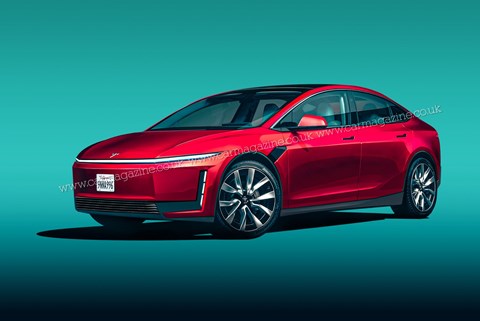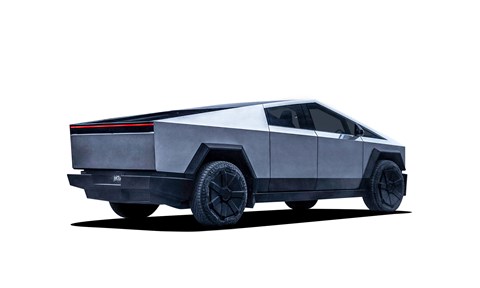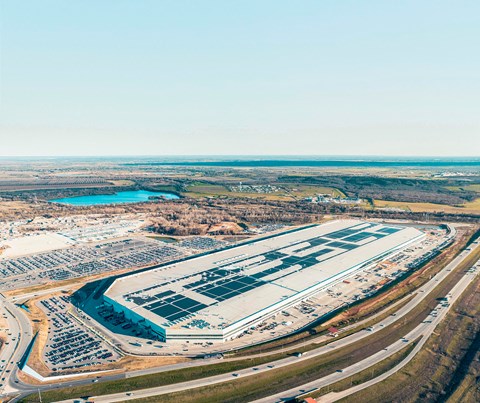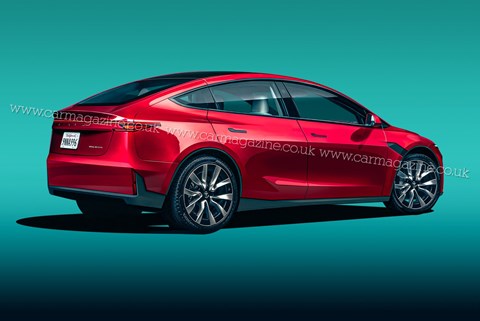► A detailed analysis of Tesla’s business plan
► How does a cheaper Model 2 fit the vision?
► Ben Oliver weighs up Tesla’s EV strategy
Whatever the Tesla Model 2 is called and whenever it finally arrives, there’s a chance it might finally turn its maker into the last thing Elon Musk thought it would become: a mass-scale global car manufacturer on a par with General Motors or Hyundai at six or seven million cars per year, or more.
Not that Tesla is exactly a minnow now. Its current share price may be half what it was at its peak but it is still more than double that of its nearest rival, Toyota, which makes more than 10 million cars each year. Tesla has just been overtaken by BYD as the world’s largest EV maker, but the 1.85 million cars it made in 2023 is still an increase of 35 per cent on the year before: growth the legacy car makers can only dream of.
That gap between share price and scale shows the markets think there’s much more growth to come. They always have. Like other hot tech stocks, Tesla’s seemingly insane valuation has been uncorrelated to its present performance, however strong. The growth of its share price and its sales is despite its spasmodic development as a car maker, and the controversies that swirl around a founder who is about the last person you’d put in charge of what is now a large-scale industrial enterprise.

But the launch of the Model 2 (above), or whatever Elon chooses to call it, may be the moment when that gap starts to close: when the various strands of Tesla’s business, which have developed so unevenly until now, finally start to align, just as the global geopolitical picture shifts decisively in its favour too. When CAR first started talking to Musk back in the late Noughties he had no desire to build cars at scale and to quality, which he knew was a near-impossible task from a standing start. Instead he was sure that an established car maker would buy him out. But pretty soon they couldn’t afford him, and before the end of this decade Tesla might be exactly the kind of whale he once thought would swallow his minnow.
There are four strands to the Tesla story in the Model 2 era, the first of which is product. Despite its scale, Tesla still doesn’t have a rational model range, or conventional product cycles in which these models get replaced every four or five years. Instead it still sells the Tesla Model S – now a beyond-pensionable 12 years old, and which already looked a bit like a lot of other cars when it launched – alongside the Cybertruck (below), easily the maddest-looking vehicle from a mainstream car maker. ‘When Tesla finally makes a palatable three-row SUV and a pick-up that looks like a Model 3,’ investor and analyst Reilly Brennan wrote recently, ‘it is possible that it will be a company on the scale of VW or Toyota.’

The Model 2 alone plainly won’t plug all the holes in Tesla’s random range. But at around $25,000 it is exactly the EV that buyers want right now. Rivals from VW to BYD agree, and are either planning or already selling their own, but Tesla’s more affordable EV is likely to be more appealing for its intrinsic qualities. It’s bound to be quick, with a decent range, and have the same brilliantly reductive design as the Model 3, with an advance order book even longer than that new Tesla generated by the time it finally went on sale. Tesla’s brand image is based on being smart, not expensive, so a cheaper model will benefit from that rather than dilute it.
The next strand is production. Once, trying to ramp up his first factory to the volumes his customers wanted and the quality they expected was the bane of Musk’s otherwise gilded life. ‘Building cars is hard,’ he admitted, while the established car makers rolled their eyes and reminded him that it had taken some of them a century to learn how to build a Golf or a C-Class or a Leaf that well.

But now it looks like Tesla may be giving the lessons. Its quality is still way behind that of its established rivals, but it is building cars at margins that make those rivals weep. While Stellantis CEO Carlos Tavares is warning of a ‘bloodbath’ among the legacy car makers if they try to sell $25,000 electric cars without paying close attention to their costs, Tesla has been slashing the prices of its cars and still making huge profits. Model 2 (our artist’s impression, below) will go further, with a radically simplified production technique that will reduce manufacturing costs and ought to improve quality too. Tesla says it will make 40 million Model 2s over its life: all of them at a fat margin.

Or will it? The third strand of this story is all the stuff that has been distracting Tesla from building a coherent model range, but which may finally start to make sense – and money – as its scale starts to go supernova: the Supercharger network, Full Self-Driving (FSD), over-the-air software updates, its energy generation and storage products, the sale of regulatory emissions credits, and income from leasing and insurance. Tesla had revenues of nearly $100bn in 2023, of which $14bn came from its energy products and other services, with income from FSD and other software included in its $82bn of automotive revenues.
Terrifyingly for its rivals, Musk has said that once Tesla acquires sufficient scale he could sell his cars for cost and make all of his profit from this other stuff. Will he? Probably not entirely: future profits are likely to be a balance of both. But Model 2 will give Tesla the huge additional volumes its other stuff requires to make serious money very quickly. Musk has already shown a willingness to slash prices and margins to maintain growth in a way that the established car makers can’t match; and when lower prices mean more users and data and non-car revenue, he’ll be tempted to slash more. He says that a Tesla app store would make sense with around 10 million of its cars on the road, a number it’ll hit within two years. An official API (application programming interface) has just been released allowing third parties to develop apps for Tesla vehicles, and soon the ecosystem the company is creating around its cars will be as much of an attraction to buyers as it is a source of profit.
The last big theme here is beyond Tesla’s control but plays straight into its hands. Governments around the world see the huge importance of EV and battery manufacturing to their future economic security. They also see that those supply chains are still nascent and pliable and can be influenced. Spooked by the disruptions caused by Covid, the war in Ukraine and the threat of conflict in Taiwan, the US in particular is busy throwing grants and incentives at manufacturers and consumers alike to build and buy more American-made EVs, with battery components and minerals sourced in the US or from friendly and reliable nations. The EU can’t match the scale of the Biden administration’s spending on this, but both are considering higher tariffs on Chinese-made EVs to counteract the colossal subsidies that the Chinese state is pumping into its car makers to counteract slumping domestic demand and open up export markets with unanswerably cheap cars.

Tesla will be affected by this: the US Inflation Reduction Act cut the $7500 federal grants from the base and long-range variants of the Model 3, for example, because too much of the value of their batteries is still sourced from ‘foreign entities of concern’. But others were hit harder, and with gigafactories in the US, Europe and China already making Model 3 and capable of building Model 2, Tesla is uniquely placed to navigate and even benefit from the reshoring, unwinding of globalisation and even trade wars that are set to dominate global economics generally and the electric car market specifically over its new model’s lifespan.
So how big will Tesla get with the Model 2, and whatever else it adds in the meantime? Will it go from nearly two million cars each year to Ford’s scale at four million, or GM’s at six million, or Toyota’s at 10 million? If it’s making those cars more profitably than any of its rivals and making more money still on software and services, it probably doesn’t matter – other than to the ego of its founder, assuming he hasn’t imploded by then.